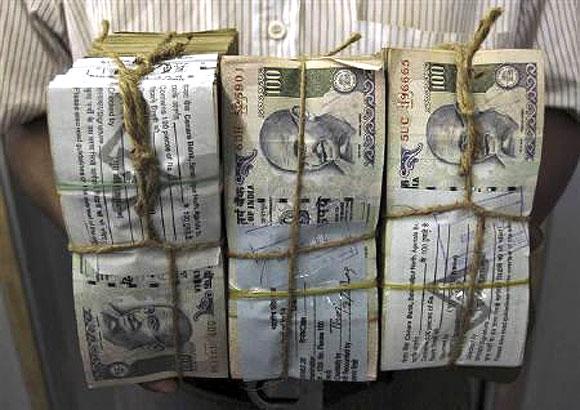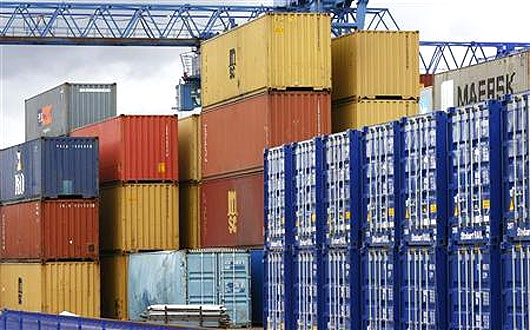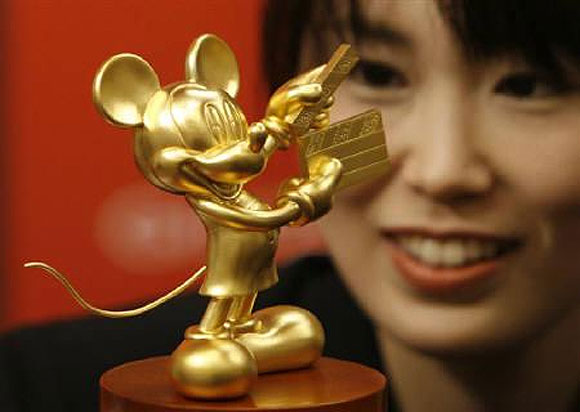Photographs: Jayanta Dey/Reuters T N Ninan
The calculations on the inflation-adjusted value of the rupee are deceptive
When the rupee takes a tumble, people start thinking that things are going wrong with the economy.
Conversely, if the rupee were to suddenly appreciate, people would take comfort - as they did briefly last year.
But the fact is that, at the end of March, when the rupee could be traded at 54 to the dollar, it was overvalued by about six per cent in inflation-adjusted terms.
Since then the currency has fallen 10 per cent. That is not enough, because the calculations on the inflation-adjusted value of the rupee are deceptive - the Reserve Bank of India takes the wholesale price index for India and consumer price indices for other countries, when everyone knows that consumer prices have been rising faster.
So a properly inflation-adjusted value for the rupee, using the consumer price index for India too, would take the currency to levels significantly lower than Rs 60.
Only then will Indian producers be able to compete effectively in world markets - and also in the domestic market against imported competition, thus giving a powerful boost to domestic output, and economic growth.
Click on NEXT for more...
Why the rupee needs to fall some more
Image: Shipping containers stand in a transport yard.Photographs: Phil Noble/Reuters
Remember that India has one of the largest trade deficits in the world, in relation to its GDP.
Last month, for instance, the deficit in goods trade was twice Japan’s - which has a three times bigger economy, and which nevertheless is pushing to weaken the yen. Instead of getting alarmed about where the rupee has fallen, we should be looking for it to fall some more.
Because trade deficits that are at historically high levels and which stay at those levels carry a simple message: lost competitiveness.
Till about 2004-05, the trade deficit was mostly explained by net oil imports and, therefore, was a resource endowment issue.
Few remember that in 11 out of 14 years since reforms got kicked off in 1991-92, the country actually had a non-oil trade surplus. That picture has changed, and how.
Last year, the trade deficit was a record $191 billion, of which oil accounted for $109 billion. Even without oil, therefore, trade in goods was in deficit by $82 billion - a very high 4.5 per cent of GDP.
Click on NEXT for more...
Why the rupee needs to fall some more
Image: Ayako Kikuchi, an employee of jewellery maker Ginza Tanaka, poses with a statue of Mickey Mouse in Tokyo.Photographs: Toru Hanai/Reuters
In the last couple of years, there has been the additional factor of gold imports - which totalled $54 billion last year ($48 billion, net of exports), or three times the level five years earlier.
Import quantities surged too, reaching 950 tonnes each year in 2010 and 2011, compared to an average of barely 600 tonnes in the previous four years.
But the bull run is over. Imports have fallen back, as gold prices have dropped from $1,900 per ounce in August 2011 to under $1,300.
Some people may still rush to buy gold, expecting prices to revert to higher levels, but even the same level of imports will now cost less.
Also, people would buy less gold if financial savings instruments were made more attractive. So offer a deaf ear to the clamour for lower interest rates.
Click on NEXT for more...
Why the rupee needs to fall some more
Photographs: Reuters
This should help turn attention to the underlying problem - the non-oil, non-gold deficit, which has been $34 billion in each of the last two years, and averaged $25 billion in the four years before that.
What should the government do?
It should shift focus, from financing the deficit to tackling the deficit.
Increase the production of coal, whose imports have multiplied five-fold in the last decade.
Raise the output of exportable iron ore.
Get out more gas, which can fire up idle power stations.
Even without getting into larger systemic issues about what hampers exports, these along with lower gold imports can bring the trade picture under control. We will head into a macroeconomic crisis only if there is continued managerial failure.






article